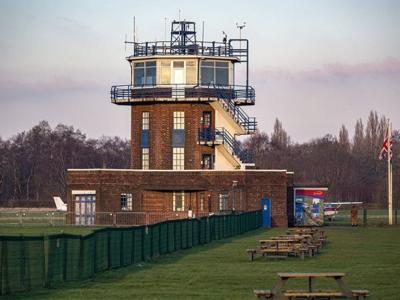Fri, Jul 21, 2023
ADS-B Position Data System Approved by U.K. CAA
The U.K. Civil Aviation Authority (CAA) has formally approved Manchester Barton Aerodrome’s (EGCB) ADS-B Flight Information Display (FID) utilizing the uAvionix pingStation to receive ADS-B position data from aircraft on the ground and flying in the vicinity of the airfield. The low-cost safety system provides real-time position data to air traffic staff operating in the tower and is the first ever FID approved for use in the UK under the CAA’s new FID regulations.

The concept of a Flight Information Display is a recognition that the use of ADS-B OUT-equipped aircraft enables low-cost airspace and aerodrome/airport situational awareness at a cost and scale not previously imagined. Prior to the advent and widespread adoption of ADS-B, multi-million-dollar radar solutions were required to provide surveillance capabilities. These technologies were cost-prohibitive, leaving most aerodromes/airports without any technological surveillance capability at all, instead relying on the line-of-sight visual capabilities of controllers in combination with radio communications. Since ADS-B OUT equipment relies on readily available certified or qualified equipment broadcasting the aircraft’s position from an approved high-integrity position source, the ground-based surveillance and display capability needed to provide situational awareness can be produced at a fraction of the cost of the legacy radar solutions.
Barton’s FID uses a uAvionix pingStation to receive ADS-B position data that is passed to the local FID computer, which displays the traffic situation to the Flight Information Service Officer (FISO) in the tower. For many years, general aviation pilots have had access to technology, such as the uAvionix SkyEcho2, enabling them to receive and display the position of other ADS-B conspicuous aircraft flying nearby to help avoid collisions. The CAA approved FID now provides an equivalent low-cost capability for FISOs and Air Traffic Control Officers (ATCOs) in the airfield tower.

The new CAA FID regulations were developed following extensive UK trials that gathered data to validate the safety case for allowing non-radar rated FISOs and ATCOs to use ADS-B information for the reporting of traffic information to pilots. “The culmination of the trials, the announcement of the new regulations, and the Barton Aerodrome approval represent a significant enhancement to flight safety by bringing a low-cost surveillance solution to general aviation airfields using off the shelf hardware and applications that can be easily implemented,” noted Steve Hutt, CEO of Custom Chess Company, who guided the effort at Barton Aerodrome and oversaw the creation of FID templated documentation as a shared resource for all UK airfields.
More News
Outboard Section Of The Right Wing And The Right Flap Separated In Flight And The Airplane Impacted A Farm Field Analysis: The pilot was approaching his destination airport under i>[...]
Final Approach Fix The fix from which the final approach (IFR) to an airport is executed and which identifies the beginning of the final approach segment. It is designated on Gover>[...]
"Our choice of when to respond, how to respond and on which targets to respond is a consideration that we make every time... Netanyahu also noted that anyone attacking Israel &ldqu>[...]
Estimated (EST) When used in NOTAMs “EST” is a contraction that is used by the issuing authority only when the condition is expected to return to service prior to the e>[...]
Aero Linx: Coalition of Airline Pilots Associations (CAPA) The Coalition of Airline Pilots Associations (CAPA) is the world’s largest pilot trade association representing ove>[...]
 NTSB Final Report: Cessna 177B
NTSB Final Report: Cessna 177B ANN's Daily Aero-Term (05.08.25): Final Approach Fix
ANN's Daily Aero-Term (05.08.25): Final Approach Fix Aero-News: Quote of the Day (05.08.25)
Aero-News: Quote of the Day (05.08.25) ANN's Daily Aero-Term (05.09.25): Estimated (EST)
ANN's Daily Aero-Term (05.09.25): Estimated (EST) ANN's Daily Aero-Linx (05.09.25)
ANN's Daily Aero-Linx (05.09.25)




